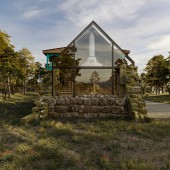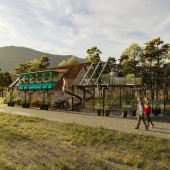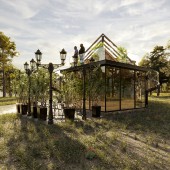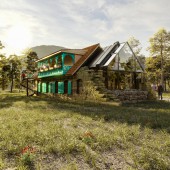
| THE AWARD |
| CATEGORIES |
| REGISTRATION |
| SUBMIT YOUR WORK |
| ENTRY INSTRUCTIONS |
| TERMS & CONDITIONS |
| PUBLICATIONS |
| DATES & FEES |
| METHODOLOGY |
| CONTACT |
| WINNERS |
| PRESS ROOM |
| GET INVOLVED |
| DESIGN PRIZE |
| DESIGN STORE |
| THE AWARD | JURY | CATEGORIES | REGISTRATION | PRESS | WINNERS | PUBLICATIONS | ENTRY INSTRUCTIONS |
Family Hotel Art by Darejan Shatashvili |
Home > Winners > Design #158938 >Interview |
 |
|
FS: What is the main principle, idea and inspiration behind your design?
DS: The inspiration for my design originated from the ruins found in the project area, which were only the stone walls of a small building previously used as a cow shed. I chose to preserve these stone ruins to honor the building's antiquity. Motivated by the unique natural surroundings of mountains and forests, I envisioned transforming these ruins into a boutique hotel. This concept required integrating modern amenities while respecting and adapting to the natural environment, guiding the development of the building in a way that seamlessly blends the old with the new.
FS: What has been your main focus in designing this work? Especially what did you want to achieve?
DS: My main focus in designing this work was to create a building that combines elements of ancient, modern, and traditional architecture. I aimed to design a structure that is not only aesthetically pleasing but also functional and well-adapted to its natural surroundings, ensuring that it complements the landscape while meeting contemporary needs.
FS: What are your future plans for this award winning design?
DS: Receiving this award will undoubtedly draw public attention to the design of the building, potentially increasing its user base. As the designer, my plan is to leverage the award to maximize exposure for the project, aiming to reach the widest possible audience and highlight the award
FS: How long did it take you to design this particular concept?
DS: It took about a month to develop the concept. Notably, the initial idea that emerged at the beginning of the process remained unchanged throughout the development phase.
FS: Why did you design this particular concept? Was this design commissioned or did you decide to pursuit an inspiration?
DS: The concept of transforming the existing ruins into a hotel stemmed from my research of the project area. The natural beauty of the site, ideal for tourism, inspired the idea. The new parts of the building, particularly the glass construction, were designed to complement the harsh, snowy winters typical of the mountainous location. For this reason, the building features a pitched roof. The hotel lounge area, which offers forest views, includes a stained-glass facade with a glass roof. To address the snow load, an automatic electric field is activated on the glass to ensure snow melting. My primary goal was to seamlessly integrate elements of antiquity, modernity, and traditional architecture in this design.
FS: Is your design being produced or used by another company, or do you plan to sell or lease the production rights or do you intent to produce your work yourself?
DS: This design is unique and exclusive, and I have no plans to create any analogues or reproduce the exact style for other projects. While I do create buildings with a similar architectural style, each structure is radically different from the others. I value originality in each project, ensuring that no two buildings are the same. -
FS: What made you design this particular type of work?
DS: The design of this hotel was inspired by the desire to create a unique and harmonious blend of historical and modern elements. The hotel features four guest rooms, a lounge with forest-facing stained glass, and a similarly styled dining room/ cafe extending along the longer part of the building. Nestled within the ruins, the guest rooms are spread across the first and second floors, connected by a lounge that ascends to a central fireplace on the upper floor. The integration of a modern glass structure with the ancient ruins, especially with views of the forest, provides a compelling solution for the hotel lounge, both functionally and visually. This project emphasizes a stylistic fusion of forms and materials, focusing on contrasting different styles to enhance the variety and depth of the architectural expression.
FS: Where there any other designs and/or designers that helped the influence the design of your work?
DS: The glass pyramid at the Louvre, designed by I.M. Pei, significantly influenced my approach to blending antiquity with modernity. This iconic structure exemplifies how modern architectural elements can be integrated with historical contexts in a way that both preserves and enhances the original. Inspired by this, I have focused on reconstruction projects that honor historical integrity while incorporating contemporary design, driving my development as an architect specializing in this transformative approach.
FS: Who is the target customer for his design?
DS: The target customers for this hotel design are tourists visiting Abastumani, Georgia, who seek a unique and picturesque lodging experience. Additionally, this project serves as a compelling case study for property owners with small, abandoned ruins, demonstrating that transformation into a boutique hotel is not only feasible but can also preserve and celebrate historical architecture. This design exemplifies how even challenging, small-scale ruins can be innovatively adapted to meet modern standards, offering inspiration and practical solutions for similar reconstruction efforts.
FS: What sets this design apart from other similar or resembling concepts?
DS: This design distinguishes itself from similar projects primarily through its innovative stylistic solutions and the challenge of integrating these within a compact space. Unlike typical modern boutique hotels that often have the luxury of larger areas, this project successfully employs creative architectural methods to maximize a smaller footprint, effectively blending functionality with distinctive style, making it uniquely appealing.
FS: How did you come up with the name for this design? What does it mean?
DS: To me, this hotel is not just a building but a work of art that embodies creativity and comfort in its design and ambiance, making "Art" a fitting name that captures the essence of this unique accommodation.
FS: Which design tools did you use when you were working on this project?
DS: At first I worked on the concept for some time as sketches on paper, then I made a mock-up, then I also began to scale and draw on paper, and when I was sure that it was exactly the concept I had in mind, I began to draw it on the computer
FS: What is the most unique aspect of your design?
DS: The most unique aspect of this design is the seamless integration of ancient ruins with a modern stained-glass structure, which strikingly contrasts yet complements the historical context. Additionally, the inclusion of balconies that feature traditional architectural elements adds a distinctive touch, blending heritage with contemporary design in a visually compelling manner.
FS: Who did you collaborate with for this design? Did you work with people with technical / specialized skills?
DS: For this project, I collaborated with 3D visualization specialists.
FS: What is the role of technology in this particular design?
DS: The technology incorporated into this design serves a crucial role in mitigating the potential damage caused by heavy snowfall. By integrating a special electric field within the frame of the glass roofing, activated by sensors or a control panel, the system can generate heat to melt snow accumulation. This proactive approach not only prevents damage to the glass from the weight of the snow but also ensures the safety and functionality of the structure. Essentially, technology is utilized here to enhance the resilience and durability of the design in adverse weather conditions.
FS: Is your design influenced by data or analytical research in any way? What kind of research did you conduct for making this design?
DS: Conducting a survey of the project area provided valuable insights into the environmental conditions and potential challenges. Subsequently, studying aspects such as snow and wind loads, and their effects on buildings, especially on glass structures, allowed for a more informed decision- making process. By utilizing the method of automatic snow melting on the glass, based on this research, the design is tailored to address specific challenges and optimize the performance of the structure in the given conditions. This approach ensures that the design is not only aesthetically pleasing but also practical and resilient.
FS: What are some of the challenges you faced during the design/realization of your concept?
DS: Addressing snow loading was the primary challenge encountered during the design and realization of the concept. However, with a sound understanding of physics principles and relevant experience, this challenge was effectively resolved.
FS: How did you decide to submit your design to an international design competition?
DS: I submitted the design to an international competition because I believe it deserves recognition and public attention. Winning a unique award reinforced my commitment to presenting even better projects in the future at A' Design Award. This recognition motivates me to push the boundaries of creativity and excellence in design.
FS: What did you learn or how did you improve yourself during the designing of this work?
DS: I learned how to turn ruins into a modern, artistic hotel, for balance functionality with aesthetics and find innovative solutions to preserve history while adding modern amenities.
FS: Any other things you would like to cover that have not been covered in these questions?
DS: I'd like to express my gratitude to the A' Design Award for providing the platform to showcase this project to a global audience. It's been an invaluable opportunity to share our work and receive recognition for our efforts. Thank you for allowing us to contribute to the design community and inspire others with our innovative approach.
FS: Thank you for providing us with this opportunity to interview you.
A' Design Award and Competitions grants rights to press members and bloggers to use parts of this interview. This interview is provided as it is; DesignPRWire and A' Design Award and Competitions cannot be held responsible for the answers given by participating designers.
| SOCIAL |
| + Add to Likes / Favorites | Send to My Email | Comment | View Press-Release |





